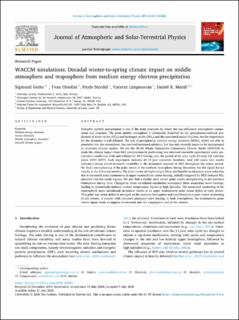WACCM simulations: Decadal winter-to-spring climate impact on middle atmosphere and troposphere from medium energy electron precipitation
Peer reviewed, Journal article
Published version
Permanent lenke
https://hdl.handle.net/11250/2679139Utgivelsesdato
2020Metadata
Vis full innførselSamlinger
- Publikasjoner fra Cristin - NILU [1377]
- Vitenskapelige publikasjoner [1112]
Originalversjon
Journal of Atmospheric and Solar-Terrestrial Physics. 2020, 209, 105382 10.1016/j.jastp.2020.105382Sammendrag
Energetic particle precipitation is one of the main processes by which the sun influences atmospheric composition and structure. The polar middle atmosphere is chemically disturbed by the precipitation-induced production of nitric oxides (NOx) and hydrogen oxides (HOx) and the associated ozone (O3) loss, but the importance for the dynamics is still debated. The role of precipitating medium energy electrons (MEEs), which are able to penetrate into the mesosphere, has received increased attention, but has only recently begun to be incorporated in chemistry-climate models. We use the NCAR Whole Atmosphere Community Climate Model (WACCM) to study the climate impact from MEE precipitation by performing two idealized ensemble experiments under pre-industrial conditions, with and without the MEE forcing, over the period of the solar cycle 23 (only full calendar years, 1997–2007). Each experiment includes 20 11-year ensemble members, total 220 years. Our results indicate a strong month-to-month variability in the dynamical response to MEE throughout the winter period. We find a strengthening of the polar vortex in the northern hemisphere during December, but the signal decays rapidly in the following months. The polar vortex strengthening is likely attributable to planetary wave reduction due to increased zonal symmetries in upper stratospheric ozone heating, initially triggered by MEE-induced NOx advected into the sunlit regions. We also find a similar early winter polar vortex strengthening in the southern hemisphere during June. Changes in mean meridional circulation accompany these anomalous wave forcings, leading to dynamically-induced vertical temperature dipoles at high latitudes. The associated weakening of the stratospheric mean meridional circulation results in an upper stratospheric polar ozone deficit in early winter. This polar cap ozone deficit is strongest in the southern hemisphere and contributes to a polar vortex weakening in late winter, in concert with increased planetary wave forcing. In both hemispheres, the stratospheric polar vortex signal seems to migrate downwards into the troposphere and to the surface.

